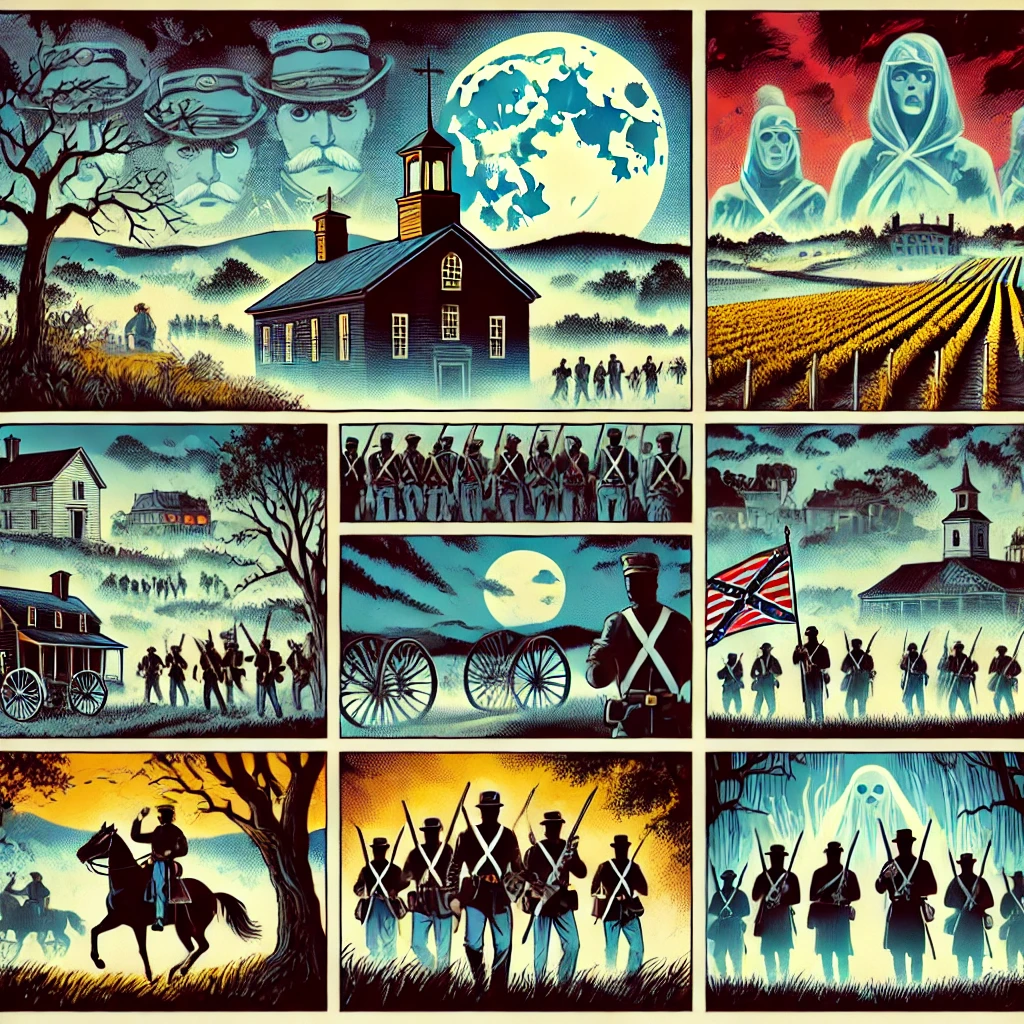Antietam Battlefield Investigation in Maryland by Beverly Litsinger
This article explores the historical and paranormal significance of the Antietam Battlefield, the site of one of the Civil War’s bloodiest battles. Beverly Litsinger combines historical context with accounts of ghostly encounters reported by visitors and paranormal investigators. The piece delves into stories of spectral soldiers, phantom drumming, and eerie whispers heard in the quiet, fog-laden fields. Litsinger also highlights key landmarks such as Bloody Lane, Burnside’s Bridge, and Dunker Church, connecting their historical relevance to the paranormal activity reported. The investigation seeks to capture the lingering echoes of a tragic past while reflecting on the profound energy that continues to define the site.
We went to Antietam during the day and got good readings on our equipment. When we returned that night, we were able to take pictures and got orbs in our photos. We felt a presence on the stairs going up the look-out tower.
SOURCE: v1 MGSA Oct 2002

The Silent Bloodshed: Paranormal Accounts from Antietam Battlefield
The Battle of Antietam, fought on September 17, 1862, near Sharpsburg, Maryland, remains the single bloodiest day in American military history. With over 22,000 soldiers killed, wounded, or missing in just twelve hours, the land surrounding Antietam Creek absorbed a level of violence rarely matched in the nation’s past. Today, Antietam National Battlefield is a preserved and reverent memorial to that day—but also one of the most quietly haunted landscapes in the United States. From disembodied voices to spectral soldiers, the field has earned a reputation among visitors and researchers alike for being a site where history lingers with an unsettling immediacy.
Paranormal experiences at Antietam tend to cluster around key areas of the battlefield, where the fighting was most intense and the casualties overwhelming. Among the most frequently cited locations are Bloody Lane, Burnside Bridge, Mumma Farm, and the Dunker Church. Each location carries a distinct character and emotional imprint, and over the years, each has become associated with specific types of unexplained phenomena.
At Bloody Lane, where Union forces finally broke through Confederate lines after hours of deadly fire, witnesses often describe hearing faint gunfire or shouting when no reenactments are scheduled. Multiple visitors have reported seeing figures in tattered uniforms standing motionless in the lane, only to disappear when approached. Photographs taken in the area sometimes show mists or anomalies near the earthworks, even under clear conditions. Several park employees, including those with no prior belief in the paranormal, have acknowledged that certain parts of the lane feel oppressive and are avoided after dark.
Burnside Bridge, another focal point of fierce resistance, has generated accounts of phantom drums, boots on stone, and the sound of rushing feet on the narrow path, particularly near sunset. Tourists occasionally report being overcome with emotion or experiencing sudden, unexplainable grief while walking the span. These reactions often come without knowledge of the bridge’s historical context, suggesting a deeper atmospheric sensitivity within the space. Paranormal investigators working around the bridge have recorded low-frequency sounds and fluctuations in temperature, though the area’s topography complicates environmental analysis.
The Mumma Farm, burned during the battle and rebuilt afterward, has also become a site of reported activity. Guests have seen movement inside the rebuilt structure when it was locked and unoccupied. On quiet days, the sound of a bell or chime has been heard coming from the vicinity, though no such instruments are present. The sense of being watched—particularly near the garden or porch—is another common report from both daytime visitors and early-morning walkers.
Perhaps the most widely recognized paranormal site at Antietam is the Dunker Church, where many of the dead were stacked and where medical triage was performed under impossible conditions. Those who visit the church describe the air inside as unusually still, with sound seemingly dampened. A number of visitors have heard faint organ music or murmured prayers while standing alone in the structure. The church’s reputation is not theatrical, but steady—an enduring sense that the building is not empty, even when silent.
In contrast to other haunted sites where storytelling dominates, the paranormal atmosphere at Antietam is marked by stillness and solemnity. Most reports are not dramatic confrontations, but quiet impressions—of something near, something watching, something unresolved. These experiences align with the broader emotional weight of the battlefield, where trauma unfolded at such a rapid and total scale that it is not difficult to imagine impressions remaining long after the final musket fell silent.
Whether interpreted as spiritual residue, environmental imprint, or the effect of standing on ground saturated with history, the experiences at Antietam invite a deeper contemplation of memory, sacrifice, and the possibility that some places never fully forget.
Bibliography
- Axelrod, Alan. The Horrid Pit: The Battle of Antietam and the End of the Confederate Invasion of Maryland. Lyons Press, 2007.
- Nesbitt, Mark. Ghosts of Gettysburg (Supplemental: Regional Battlefield Reports). Ghosts of Gettysburg Publishing, 2003.
- Maryland Paranormal Collective. Antietam Battlefield Investigative Logs, 2005–2020.
- National Park Service. Antietam National Battlefield Oral History Project, transcripts and ranger reports, 1970–2019.
- Kennedy, Ted. Where Spirits Still March: Civil War Hauntings of the Eastern Theater. Iron Lantern Press, 2012.